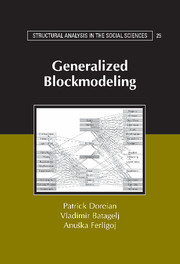Book contents
- Frontmatter
- Contents
- Preface
- 1 Social Networks and Blockmodels
- 2 Network Data Sets
- 3 Mathematical Prelude
- 4 Relations and Graphs for Network Analysis
- 5 Clustering Approaches
- 6 Optimizational Approach to Conventional Blockmodeling
- 7 Foundations for Generalized Blockmodeling
- 8 Blockmodeling Two-Mode Network Data
- 9 Semirings and Lattices
- 10 Balance Theory and Blockmodeling Signed Networks
- 11 Symmetric–Acyclic Blockmodels
- 12 Extending Generalized Blockmodeling
- Bibliography
- Author Index
- Subject Index
- Titles in the series
6 - Optimizational Approach to Conventional Blockmodeling
Published online by Cambridge University Press: 13 January 2010
- Frontmatter
- Contents
- Preface
- 1 Social Networks and Blockmodels
- 2 Network Data Sets
- 3 Mathematical Prelude
- 4 Relations and Graphs for Network Analysis
- 5 Clustering Approaches
- 6 Optimizational Approach to Conventional Blockmodeling
- 7 Foundations for Generalized Blockmodeling
- 8 Blockmodeling Two-Mode Network Data
- 9 Semirings and Lattices
- 10 Balance Theory and Blockmodeling Signed Networks
- 11 Symmetric–Acyclic Blockmodels
- 12 Extending Generalized Blockmodeling
- Bibliography
- Author Index
- Subject Index
- Titles in the series
Summary
Our explicit treatment of blockmodeling starts here and continues to the end of the book. We remind readers that blockmodeling provides a way of discerning fundamental structures in networks and permits the delineation of role systems. As a practical matter, most of the prior empirical work on blockmodeling was done within an approach that we have characterized as conventional blockmodeling (Section 1.5), and it is our point of departure here. Given our broader objective of replacing all of the features of conventional blockmodeling with the features of what we have called generalized blockmodeling, this chapter breaks naturally into two parts. One contains the foundational ideas of blockmodeling and the other develops the essential foundations of generalized blockmodeling. An indirect method proceeds by analyzing some transformation of the network data, whereas a direct method works with the network data themselves. By the end of this chapter, we develop a direct method to replace the indirect method and an optimization approach for delineating and fitting blockmodels. In this chapter, we stay within the framework of using structural and regular equivalence. The development of new block types, together with new types of blockmodels, starts in Chapter 7.
CONVENTIONAL BLOCKMODELING
The procedural goal of blockmodeling is to identify, in a given network, clusters (classes) of units (actors) that share structural characteristics defined in terms of some relation R. Each cluster forms a position. The units within a cluster have the same or similar connection patterns. Clusters form a partition C = {C1,C2, …, Ck}, which is a special type of clustering of the set of units U (see Section 5.2).
- Type
- Chapter
- Information
- Generalized Blockmodeling , pp. 168 - 209Publisher: Cambridge University PressPrint publication year: 2004



